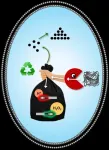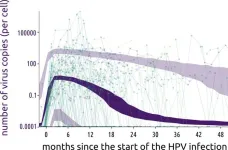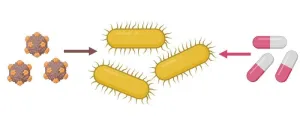(Press-News.org) A recent study from Tata Institute of Fundamental Research, Mumbai, India has revealed new details about how our cells clean up and recycle waste. This process, known as autophagy, is like a self-cleaning mechanism for cells, helping the cells stay healthy by getting rid of damaged parts and recycling useful components. The process involves formation of a vesicle called autophagosome, which encapsulates the cellular waste. The autophagosome then fuses with another type of vesicle called lysosome. The fused stage is called autolysosome. The autolysosome ultimately matures into lysosome, where the waste is degraded by different enzymes and important starting materials are released back into the cytoplasm. The autophagosomes, autolysosomes and lysosomes can be considered as different stages of the cellular recycling process. Therefore, when cells notice they have too much "junk" inside, autophagy kicks into action. It is like a little clean-up crew inside the cell that sorts out the waste, recycles useful parts, and disposes off the rest. However, autophagy is not just about tidying up. The process is also extremely crucial for survival. When cells face tough times, like deprivation of nutrients or oxygen, autophagy can break down older, less useful components to provide essential material and aid in survival. Hence, this is one of the most important processes in our body. Impaired autophagy is linked to cardiovascular diseases, neurodegenerative diseases like Alzheimer’s disease and Parkinson’s disease, metabolic disorders like diabetes and cancer. Various proteins and small molecules work in tandem to regulate this vital process. Dysregulation of any of the regulators can lead to disruption in autophagy. Hence, for better understanding of how autophagy works, we need to know what is happening inside the autophagic vesicles at every stage of the process. This is where this recent finding made an exciting leap forward.
Researchers focused on simultaneous tracking of two important factors: pH and hydrogen peroxide (H2O2) levels inside autophagic vesicles. Now, the question is why these two factors were chosen. The proton levels or pH inside the autophagic vesicles changes from 6-6.5 to 4.5 as we go from autophagosomes to autolysosomes to lysosomes. Therefore, pH serves as an indicator for identifying the stage of autophagy. Tracking a second analyte with pH would help in getting an idea on how the levels of second analyte fluctuate as autophagy progresses. H2O2 is a key regulator of autophagy. In healthy cells, low levels of H2O2 help promote autophagy and allow cells to adapt to stress. However, when cells experience oxidative stress, H2O2 levels can lead to autophagic failure and eventually cell death. But how? To get an answer to that and understand how autophagy can go wrong in case of different diseases, it is important to know how H2O2 behaves in the vesicles during different stages of autophagy.
In this study, researchers used novel autophagic-vesicle-targeted fluorescent sensors to track both pH and H2O2 levels simultaneously inside the autophagic vesicles. The pH sensors allowed them to identify the different stages of autophagic vesicles. Then, they used the H2O2 sensor to track the hydrogen peroxide levels at each stage of the process. Here’s where the discovery gets exciting: The scientists found that the highest levels of H2O2 were in the autolysosomes, the middle stage of autophagy. This was a surprise, as no one had previously measured H2O2 levels in the vesicles at different stages of autophagy and it was expected that the levels at the end stage would be high. The results reveal that autolysosomes have a crucial role to play in the process, and their high H2O2 content could further provide important clues about how autophagy is regulated.
What does this mean for the future? This discovery opens up new avenues for understanding autophagy in health and disease. By knowing where and when H2O2 levels peak during autophagy in the disease conditions, researchers can further explore how oxidative stress might affect the process and lead to problems in the cell. The new information could lead to new ways of treating diseases associated with impaired autophagy. Moreover, understanding the role of H2O2 in the different stages of autophagy could eventually help develop drugs or therapies that fine-tune the process, restoring balance to cells and improving health. Further exploration of these findings will provide valuable insights into how our cells stay healthy and open up exciting possibilities toward improved health.
END
New findings shed light on cell health: Key insights into the recycling process inside cells
2025-01-21
ELSE PRESS RELEASES FROM THIS DATE:
Human papillomavirus infection kinetics revealed in new longitudinal study
2025-01-21
Non-persistent human papillomavirus (HPV) infections are characterized by a sharp increase in viral load followed by a long plateau, according to a study published January 21st in the open-access journal PLOS Biology by Samuel Alizon of the National Centre for Scientific Research (CNRS), France, and colleagues.
Chronic HPV infection is responsible for more than 600,000 new cancers each year, including nearly all cervical cancers. Infection among young women is common, impacting nearly 20% of women 25 years of age. Fortunately, the vast majority of these infections ...
Antibiotics modulate E. coli’s resistance to phages
2025-01-21
In your coverage, please use this URL to provide access to the freely available paper in PLOS Biology: http://journals.plos.org/plosbiology/article?id=10.1371/journal.pbio.3002952
Article title: Chloramphenicol and gentamicin reduce the evolution of resistance to phage ΦX174 by suppressing a subset of E. coli LPS mutants
Author countries: Germany
Funding: This work was generously supported by funds from the Max Planck Society (L.P.-F.B.). L.P. was supported by the International Max Planck Research ...
Building sentence structure may be language-specific
2025-01-21
Do speakers of different languages build sentence structure in the same way? In a neuroimaging study published in PLOS Biology, scientists from the Max Planck institute for Psycholinguistics, Donders Institute and Radboud University in Nijmegen recorded the brain activity of participants listening to Dutch stories. In contrast to English, sentence processing in Dutch was based on a strategy for predicting what comes next rather than a ‘wait-and-see’ approach, showing that strategies may differ across languages.
While listening to spoken language, people need to link ‘abstract’ knowledge of grammar to ...
Biotin may shield brain from manganese-induced damage, study finds
2025-01-21
While manganese is an essential mineral involved in many bodily functions, both deficiency and excessive exposure can cause health issues. Maintaining a balanced diet typically provides sufficient manganese for most individuals; however, high levels of exposure can be toxic, particularly to the central nervous system. Chronic manganese exposure may result in a condition known as manganism, characterized by symptoms resembling Parkinson's disease, including tremors, muscle stiffness, and cognitive disturbances.
New research published in Science Signaling employs model systems and human nerve cells to show the mechanisms by which manganese inflicts damage ...
Treatment for children with obesity has lasting effect
2025-01-21
When children with obesity undergo weight-loss treatment, the effects have repercussions later in life and the risk of serious health problems and premature death is lower as they reach young adulthood. However, this is not the case for depression and anxiety, a study from Karolinska Institutet published in JAMA Pediatrics reports.
The study shows that children and adolescents who respond well to obesity treatment are less likely to develop obesity-related diseases, such as type 2 diabetes, hypertension and dyslipidaemia (abnormally high levels of fat in the blood) as young adults.
The treatment studied ...
Spotted hyena found in Egypt for the first time in 5,000 years
2025-01-21
A spotted hyena (Crocuta crocuta) has been found in South Eastern Egypt: the first recorded instance of the creature in this region for thousands of years.
The lone individual was caught and killed by people around 30km from the border with Sudan, a paper in De Gruyter’s Mammalia reports.
“My first reaction was disbelief until I checked the photos and videos of the remains,” said the study’s lead author, Dr. Adbullah Nagy from Al-Azhar University, Egypt. “Seeing the evidence, I was completely taken aback. It was beyond anything we had expected to find in Egypt.”
The sighting took place some 500km north of the known range of spotted ...
SignGPT – Project awarded £8.45m to build a sign language AI model for the Deaf community
2025-01-21
A large-language model (LLM) built to meet the needs of the Deaf community, translating between signed and spoken language, is the aim of a new project led by the University of Surrey.
SignGPT: Building Generative Predictive Transformers for Sign Language has been awarded £8.45m from the UK Engineering & Physical Sciences Research Council. The five-year project will build tools to allow spoken language to be automatically translated into photo-realistic sign language and video of sign language to be translated into spoken language – a complex translation problem that is yet to be solved.
Surrey ...
Garden ponds: Hidden gems of urban biodiversity conservation
2025-01-21
Urbanisation is rapidly transforming landscapes worldwide, becoming a key driver of global biodiversity loss. It often impacts biodiversity negatively by creating selective environments that limit species diversity in urban compared to natural habitats. Amidst this challenge, understanding and enhancing urban blue-green infrastructure is critical. Garden ponds are small yet significant water features that are increasingly common in urban areas. They offer numerous ecosystem services, like aesthetic purposes, microclimate regulation, and habitats for ornamental species. However, their role in supporting ...
Epigenetic aging and DNA-methylation as tumor markers for breast cancer
2025-01-21
“Our study contributes to the development of a DNAm biomarker that integrates conventional BC risk factors to better reflect the risk for BC subtypes, promoting epigenetically targeted preventive interventions tailored to aged individuals with high risk.”
BUFFALO, NY- January 21, 2025 – A new research paper was published in Aging (listed by MEDLINE/PubMed as "Aging (Albany NY)" and "Aging-US" by Web of Science) on December 5, 2024, Volume 16, ...
Salt deposit ring inside your pasta pan?
2025-01-21
WASHINGTON, Jan. 21, 2025 – If you’ve ever tossed a generous pinch of salt into your pasta pan’s water for flavor or as an attempt to make it boil faster, you’ve likely ended up with a whitish ring of deposits inside the pan.
A group of scientists from the University of Twente in the Netherlands and the French National Institute for Agriculture, Food, and Environment (INRAE), inspired by this observation during an evening of board games and pasta dinner, wondered what it ...








